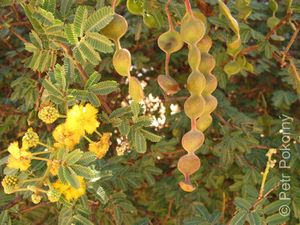Note: This is a project under development. The articles on this wiki are just being initiated and broadly incomplete. You can Help creating new pages.
Difference between revisions of "Ayurwiki:Featured Page/January/Week/2"
| Line 1: | Line 1: | ||
| − | [[File: | + | [[File:Babool(Acacia nilotica) flowers at Hodal.jpg|thumb|right|''Vachellia nilotica'',''Babul'']] |
| − | ''' | + | '''Acacia nilotica''' is a tree 5–20 m high with a dense spheric crown, stems and branches usually dark to black coloured, fissured bark, grey-pinkish slash, exuding a reddish low quality gum. |
| − | '''Uses:''' | + | '''Uses:''' Sexual problems, Eye diseases, Heal wounds, Bleeding of the uterus, Liver problems, Jaundice, Throat problems, Stomach problems, Hair problems, Skin problems. |
| − | '''Chemical Composition:''' | + | '''Chemical Composition:''' It contains Polysaccharide Arabin (Mixture of calcium, magnesium and potassium salts of arabic acid).Arabic acid on hydrolysis gives D-galactose, L-arabinose, L-rhamnose and D-glucoronic acid.Also contain enzyme oxidase and peroxidase. |
| − | <span style="width: 100%; background-color: #90EE90; padding: 10px; margin: 10px; text-align: right; clear: right; margin-left: 0;">[[ | + | <span style="width: 100%; background-color: #90EE90; padding: 10px; margin: 10px; text-align: right; clear: right; margin-left: 0;">[[Acacia nilotica - Aaavartaki|Read more]]</span> |
Revision as of 10:03, 2 February 2019
Acacia nilotica is a tree 5–20 m high with a dense spheric crown, stems and branches usually dark to black coloured, fissured bark, grey-pinkish slash, exuding a reddish low quality gum.
Uses: Sexual problems, Eye diseases, Heal wounds, Bleeding of the uterus, Liver problems, Jaundice, Throat problems, Stomach problems, Hair problems, Skin problems.
Chemical Composition: It contains Polysaccharide Arabin (Mixture of calcium, magnesium and potassium salts of arabic acid).Arabic acid on hydrolysis gives D-galactose, L-arabinose, L-rhamnose and D-glucoronic acid.Also contain enzyme oxidase and peroxidase.
